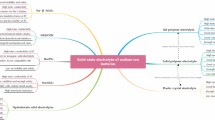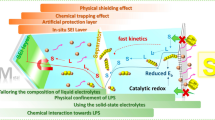Abstract
The electrochemical behavior and the electrodeposition of dysprosium (Dy) in phosphonium-cation-based ionic liquid were investigated in this study. A new group of the room-temperature ionic liquids (RTILs) based on phosphonium cations with bis(trifluoromethylsulfonyl)amide anions was applied as novel electrolytic solutions. The cyclic voltammetric measurements resulted in one step reduction of the trivalent dysprosium ion in phosphonium-cation-based ionic liquid. On the other hand, no anodic peak ascribed to the oxidation of dysprosium metal was observed in this electroanalytical study. The diffusion coefficient and the activation energy for diffusion of the trivalent Dy complex in IL were estimated using semi-integral analysis, because it is important to analyze the diffusion properties to recover Dy through electrowinning methods. The diffusion coefficient of Dy(III) which was calculated to be 2.0 × 10−12 m2 s−1 at 25 °C, closed to that of the trivalent lanthanoid ion such as Eu(III) and Sm(III) in phosphonium-cation-based ionic liquid. In addition, the activation energy for diffusion was estimated to be 65 kJ mol−1 (0.5 M) and 49 kJ mol−1 (0.075 M). The estimated activation energy for diffusion was affected by the concentration of the electrolytic solution, since the RTILs had relatively strong electrostatic interactions between the metal cations and the solvent anions. Furthermore, the electrodeposition of Dy in phosphonium-cation-based IL was carried out using a two-electrode system constructed with a copper plate cathode and dysprosium metal anode. Energy dispersive X-ray analysis of electrodeposits showed a sharply peaked spectrum corresponding to the characteristic X-ray lines of Dy. In addition, the obtained Dy, with the exception of the surface layer, was confirmed to be in the metallic electronic state by X-ray photoelectron spectroscopy.









Similar content being viewed by others
References
Kim CH, Kwon IE, Park CH, Hwang YJ, Bae HS, Yu BY, Pyun CH, Hong GY (2000) J Alloys Compd 33:311
Ryunhong G, Miura N, Matsumoto H, Nakano R (2006) J Rare Earths 24:119
Oono N, Sagawa M, Kasada R, Matsui H, Kimura A (2011) J Magn Magn Mater 323:297
Miura K, Itoh M, Machida K (2008) J Alloys Compd 466:228
Matsuura Y (2006) J Magn Magn Mater 303:344
Zhu YL, Kozuma Y, Katayama Y, Miura T (2009) Electrochim Acta 54:7502
Matsumiya M, Suda S, Tsunashima K, Sugiya M, Kishioka S, Matsuura H (2008) J Electroanal Chem 622:129
Vega JA, Zhou J, Kohl PA (2009) J Electrochem Soc 156(4):A253
Fukui R, Katayama Y, Miura T (2011) Electrochim Acta 56:190
Komaba S, Yabuushi N, Ozeki T, Okushi K, Yui H, Konno K, Katayama Y, Miura T (2010) J Power Sources 195:6069
Orita A, Kamijima K, Yoshida M, Dokko K, Watanabe M (2010) J Power Sources 196:3874
MacFarlane DR, Meakin P, Shn J, Amini N, Forsyth M (1999) J Phys Chem B 103:4164
Tsunashima K, Sugiya M (2007) Electrochem Commun 9:2354
Tsunashima K, Sugiya M (2007) Electrochemistry 75(9):734
Saïla A, Gibilaro M, Massot L, Chamelot P, Taxil P, Affoune AM (2010) J Electroanal Chem 642:150
Castrillejo Y, Bermejo MR, Barrado AI, Pardo R, Barrado E, Martínez AM (2005) Electrochim Acta 50:2047
Lodermeyer J, Multerer M, Zistler M, Jordan S, Gores HJ, Kipferl W, Diaconu E, Sperl M, Bayreuther G (2006) J Electrochem Soc 153:C242
Tachikawa N, Katayama Y, Miura T (2007) J Electrochem Soc 154(11):F211
Katayama Y, Miura T (2010) Electrochemistry 78(10):808
Fujii K, Nonaka T, Akimoto Y, Umebayashi Y, Ishigro S (2008) Anal Sci 24:1377
Zhu YL, Katayama Y, Miura T (2010) Electrochim Acta 55:9019
O’Mahony AM, Silvester DS, Aldous L, Hardacre C, Compton RG (2008) J Chem Eng Data 53:2884
Bard AJ, Faulkner LR (2001) Electrochemical methods, fundamentals and applications. John Wiley & Sons, New York, p 248
Andrade EN, Chiong YS (1936) Proc Phys 48:247
Moslemzadeh N, Barrett SD (2002) J Electron Spectrosc Relat Phenom 127:161
Handbook of X-ray photoelectron spectroscopy, ULVAC-PHI Inc
Acknowledgments
This study was partially supported by the research grant program on the Promotion of a Recycle-Based Society in 2010 from the Ministry of the Environment, Japan.
Author information
Authors and Affiliations
Corresponding author
Electronic supplementary material
Below is the link to the electronic supplementary material.
Rights and permissions
About this article
Cite this article
Kurachi, A., Matsumiya, M., Tsunashima, K. et al. Electrochemical behavior and electrodeposition of dysprosium in ionic liquids based on phosphonium cations. J Appl Electrochem 42, 961–968 (2012). https://doi.org/10.1007/s10800-012-0463-8
Received:
Accepted:
Published:
Issue Date:
DOI: https://doi.org/10.1007/s10800-012-0463-8




